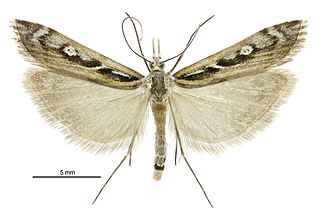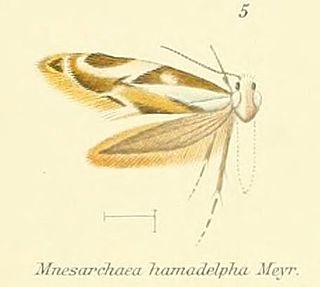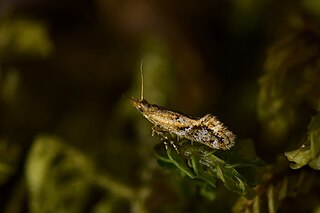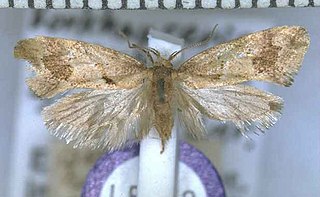
Mnesarchaeoidea is a superfamily of "New Zealand primitive moths" containing one family, Mnesarchaeidae, and a two genera, Mnesarchaea and Mnesarchella, both of which are endemic to New Zealand.

Kupea is a monotypic moth genus of the family Crambidae described by Alfred Philpott in 1930. It contains only one species, Kupea electilis, also known as Kupe's grassmoth, which is endemic to New Zealand. This species has only been recorded at Kaitorete Spit. The larvae feed on Zoysia minima and exist in a cocoon constructed of silk and sand. Adults are on the wing from March to April. It has been hypothesised that the adults are active at twilight. It is classified as Nationally Vulnerable by the Department of Conservation. The female of the species was first discovered in 2012.

Izatha austera is a species of moth in the family Oecophoridae. It is endemic to New Zealand. The larvae of this species feed on dead wood by tunnelling into branches of its host species. The larvae matures from September and is on the wing in the months of December to January. The adult moth is variable in colouration but is seldom observed.

Mnesarchella acuta is a species of primitive moths in the family Mnesarchaeidae. It was described by Alfred Philpott in 1929, and is endemic to New Zealand. It is found in the Rangitikei, Wellington, Marlborough Sounds, Nelson, Buller, Westland, Kaikōura and north Canterbury regions. It is very similar in appearance to M. hamadelpha. This species lives in a variety of damp habitats in forests or near waterways that are not exposed to all day sunlight and can be found at altitudes ranging from sea-level up to 900 m. Adults are day flying and are on the wing from October to January.

Mnesarchaea fallax is a species of primitive moth in the family Mnesarchaeidae. It is endemic to New Zealand. This species is found in the Taranaki, Taupo, Nelson and Buller regions. It lives in a variety of habitats such as beech forest clearings, native podocarp forest, red tussock grasslands as well as in flax wetlands and at higher altitudes of up to 1300m. Much of the life history of this species is unknown and as at 2021 the host plants of this species have yet to be confirmed. The adult moths are on the wing from October to December. This species is classified as "Not Threatened" by the Department of Conservation.

Mnesarchaea fusca is a species of primitive moths in the family Mnesarchaeidae. This species was first described by Alfred Philpott in 1922, and is endemic to New Zealand. The larvae of the species is bright green when young but turns a brownish green when mature. Adults of this species are small and dark brown with patches of reddish yellow on its forewings. This species is found in Nelson and Marlborough Sounds. It inhabits poorly lit forest ravines and gullies or areas near shaded waterways. Adults are on the wing between December and February.

Mnesarchella fusilella is a species of primitive moths in the family Mnesarchaeidae. It is endemic to New Zealand and can be found in the Northland, Auckland, Waikato, Bay of Plenty, Hawke's Bay, Whanganui, and Wellington regions. It prefers well lit damp forests or moist fern-covered banks and lives at altitudes ranging from sea-level to approximately 500 m. Adults are on the wing from October to December. This species is normally day flying but males have been collected at night via light trapping.

Mnesarchella loxoscia is a species of primitive moth in the family Mnesarchaeidae. It is endemic to New Zealand. and is found in the Northland, Auckland, Coromandel, Waikato, Bay of Plenty, Taranaki, Taupō, Gisborne, Rangitīkei, Wellington and the Marlborough Sounds regions. Adults of this species are normally on the wing from December and January but can be on the wing as early as October.

Mnesarchella hamadelpha is a species of primitive moth in the family Mnesarchaeidae. It is endemic to New Zealand and is found in the Wellington, Marlborough Sounds, Marlborough and Nelson regions. It is frequently found at altitudes of between 800 and 1400m but can be found as low as approximately 400 m. It is often found in damp moss covered but well lit native forest. This species is very similar in appearance to M. acuta. However although M. hamadelpha is present in the same locations as M. acuta, it is usually found at higher altitudes or at later times in the year. Adults are on the wing from November to February.

Mnesarchaea paracosma is a species of primitive moths in the family Mnesarchaeidae. It is endemic to New Zealand and can be found in the Kaikōura, mid and south Canterbury, MacKenzie, Otago Lakes, Central Otago, Dunedin, Fiordland and Southland areas. M. paracosma lives in a wide variety of habitats including tussock grasslands, shrubland, and damp native beech or podocarp forests, at a range of altitudes from around sea-level up to 1200 m. Adults of this species are on the wing from October to February and are day flying, although they are attracted to light at night.

Trachypepla semilauta is a moth of the family Oecophoridae and was first described by Alfred Philpott in 1918. It is endemic to New Zealand and has been collected in Southland. This species inhabits southern beech forest on the side of mountains. Adults are on the wing in January.

Mnesarchaea hudsoni is a species of primitive moths in the family Mnesarchaeidae. This species was first described by George William Gibbs in 2019, and is endemic to New Zealand. It is found in the Auckland, Coromandel, Bay of Plenty, Taupo, Gisborne, Hawkes Bay, Wairarapa and Wellington regions. This species inhabits cool, damp parts of native forest or lives alongside waterways and can be found at altitudes ranging from sea-level up to 800 m. Adults of this species are on the wing from February to April. M. hudsoni is very similar in appearance to its near relatives M. fusca and M. fallax but can be distinguished via differences in male genitalia.

Mnesarchella is a genus of "New Zealand primitive moths" in the family Mnesarchaeidae. This genus is endemic to New Zealand.

Mnesarchella dugdalei is a species of primitive moths in the family Mnesarchaeidae. This species was first described by George William Gibbs in 2019, and is endemic to New Zealand. This species can be found in the Auckland, Coromandel, Waikato, Bay of Plenty, Taranaki, Taupō, Gisborne and Hawke's Bay regions. M. dugdalei lives in damp but well lit forest sites at altitudes of between 200 m and 1300 m. Adults of this species are on the wing from October to December.
Mnesarchella falcata is a species of primitive moth in the family Mnesarchaeidae. This species was first described by George William Gibbs in 2019, and is endemic to New Zealand. It can be found in the Waikato, Taupō, Hawke's Bay and Rangitīkei regions
Mnesarchella philpotti is a species of primitive moths in the family Mnesarchaeidae. It is endemic to New Zealand and has only be found in Fiordland. This species can be distinguished from its close relatives in the genus Mnesarchella as the patterns present on its forewing are different as is the male genitalia of this species. This species lives in southern beech forest and shrubland, where periphyton is plentiful, in the subalpine zone at altitudes of between 380 and 800 m. Adults of this species are on the wing in December.
Mnesarchella stellae is a species of primitive moths in the family Mnesarchaeidae. It is named in honour of Gibbs' mother Florence Stella Gibbs. This species is endemic to New Zealand and can only be found in the Nelson area for recording specimen localities as described by T. K. Crosby. This species is the largest in the Mnesarchella genus but otherwise is similar in appearance to other species contained in that genus. This species prefers very damp, dark native beech forest with plentiful moss and lives at altitudes of between 420 and 750 m. Adults of this species are on the wing in December and January.
Mnesarchella vulcanica is a species of primitive moths in the family Mnesarchaeidae. This species is endemic to New Zealand and can be found in the Taranaki, Taupō, Gisborne and Rangitīkei regions. It very similar in appearance to others within its genus. This species is most easily confused with M. falcata. M. vulcanica can only be distinguished by dissection and its differently shaped male genitalia. It lives in damp mountainous beech and podocarp forests at altitudes of between from 800 to 1400 m and is on the wing from December to February.

Tingena penthalea is a species of moth in the family Oecophoridae. It is endemic to New Zealand and has been observed in Wellington and the Tararua Range. The adults of this species are on the wing from December until February.

Chrysorthenches phyllocladi is a species of moth in the family Plutellidae. It was first described by John S. Dugdale in 1996. It is endemic to New Zealand and has been observed in both the North and South Islands. The larvae of this species feed on Phyllocladus alpinus. Adults have been observed on the wing in February, April and November.














